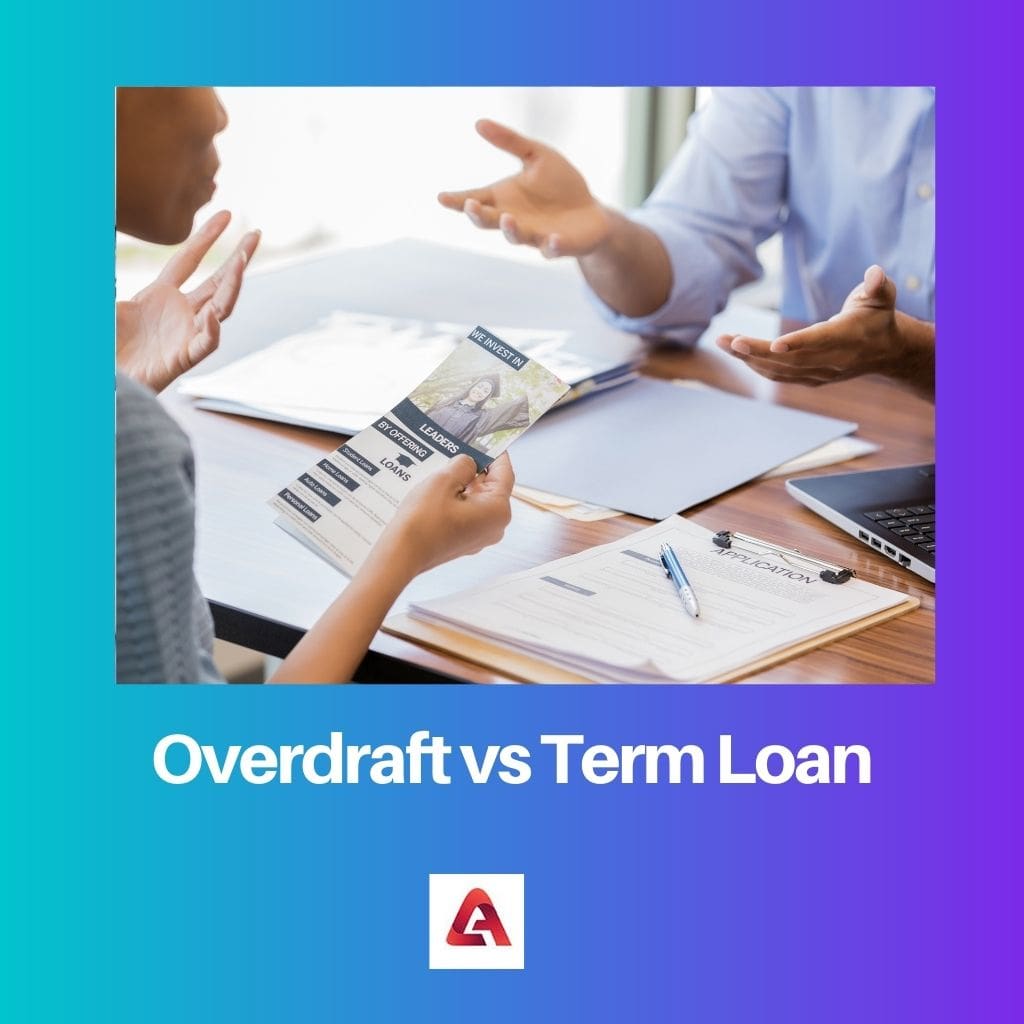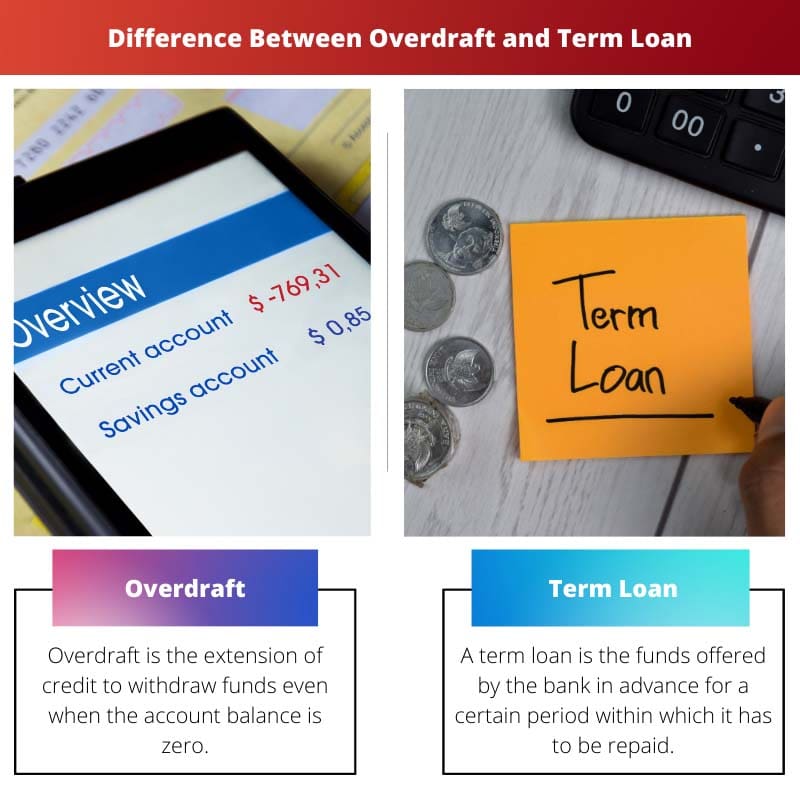An overdraft is a flexible credit facility linked to a bank account, allowing withdrawals beyond the account balance, while a term loan is a fixed amount borrowed for a specified period with regular repayments. Overdrafts offer short-term flexibility, whereas term loans provide structured, long-term financing with a set repayment schedule.
Key Takeaways
- An overdraft is a banking facility that allows account holders to withdraw more money than they have in their account up to a predetermined limit. At the same time, a term loan has a fixed repayment schedule and a specified maturity date.
- Overdrafts are flexible and can be used as needed, with interest charged only on the overdrawn amount. At the same time, term loans provide a lump sum upfront, with fixed repayments over the loan tenure, regardless of how much the loan is used.
- Overdrafts are better suited for short-term cash flow needs and managing working capital, while term loans are more appropriate for larger investments, long-term projects, or significant expenses.
Overdraft vs Term Loan
The difference between Overdraft and Term Loan is the usage, Overdraft is used for operating expense which is on a short-term basis, whereas a Term loan is used for a long term and is used to make high-value purchases.

Comparison Table
| Feature | Overdraft | Term Loan |
|---|---|---|
| Purpose | Short-term borrowing for small, unexpected expenses | Longer-term borrowing for larger purchases or projects |
| Amount | Limited credit limit, lower than a term loan | Fixed amount disbursed in one lump sum |
| Interest | Charged only on the amount used and higher than a term loan | Fixed interest rate on the entire loan amount |
| Repayment | Flexible, repay over time or in one lump sum | Fixed monthly payments over a set term |
| Collateral | Usually unsecured | May require collateral, depending on the amount and lender |
| Approval process | Generally faster and easier | Can take longer, with stricter creditworthiness checks |
| Suitability | Useful for covering small, immediate needs | Better for planned expenses or larger purchases |
| Pros | Flexibility in usage, convenient for small expenses | Predictable payments, potentially lower overall interest |
| Cons | High interest rate, potential overdraft fees | Less flexible, risk of default if you can’t make payments |
What is Overdraft?
An overdraft is a financial arrangement that allows an account holder to withdraw funds from their bank account in excess of the available balance. It serves as a short-term credit facility provided by the bank, enabling customers to make transactions or cover expenses even when their account balance is insufficient.
Key Features of Overdraft:
- Flexibility:
- Overdrafts offer flexibility as they allow account holders to borrow on an as-needed basis, up to a predetermined limit set by the bank.
- Users are charged interest only on the borrowed amount and for the period it is utilized.
- Linked to a Bank Account:
- Overdrafts are linked to a specific bank account, providing account holders with easy access to additional funds when required.
- Repayment Terms:
- Overdrafts are considered revolving credit, meaning the borrowed amount can be repaid and borrowed again without the need to reapply for the credit facility.
- Repayments are made through deposits into the linked account.
- Interest Charges:
- Interest is charged on the outstanding balance of the overdraft, and the rate may vary based on the terms agreed upon with the bank.
- Common Usage:
- Overdrafts are commonly used to manage short-term cash flow gaps, cover unexpected expenses, or address temporary financial needs.
Advantages:
- Immediate Access to Funds:
- Overdrafts provide quick and immediate access to additional funds, helping account holders meet financial obligations promptly.
- Flexible Repayment:
- The flexible nature of overdrafts allows users to repay the borrowed amount as soon as they have sufficient funds, without being tied to a fixed repayment schedule.
- Cost-Effective for Short-Term Needs:
- Overdrafts can be a cost-effective solution for short-term financial needs, as interest is only incurred on the borrowed amount and for the duration it is utilized.
Considerations:
- Interest Rates:
- Users should be aware of the interest rates associated with overdrafts, as high rates can make this form of credit relatively expensive if not used judiciously.
- Credit Limit Monitoring:
- It’s crucial for account holders to monitor their overdraft limit to avoid exceeding it, as doing so may lead to additional fees or declined transactions.
- Use as a Temporary Solution:
- While overdrafts offer quick relief, they are best suited for short-term financial challenges, and users should consider more structured financing options for long-term needs.

What is Term Loan?
A term loan is a form of borrowing where a fixed amount of money is obtained from a financial institution or lender, and it is repaid over a specified period through regular installments. Term loans are commonly used for financing long-term business investments, such as equipment purchases, expansion projects, or other capital expenditures.
Key Features of Term Loans:
- Fixed Loan Amount:
- Term loans involve borrowing a specific amount of money, which is determined at the time of loan approval. This contrasts with revolving credit facilities like overdrafts.
- Fixed Repayment Schedule:
- Repayments are structured with a predetermined schedule, monthly, and include both principal and interest components. The loan is fully amortized over the agreed-upon term.
- Interest Rates:
- The interest rate on a term loan may be fixed or variable, depending on the terms negotiated between the borrower and the lender. Fixed rates provide predictable payments, while variable rates may change over the loan term.
- Collateral Requirement:
- Term loans may require collateral to secure the loan, providing the lender with a form of security in case of default. Collateral could include assets like real estate, equipment, or inventory.
- Purpose-Specific Usage:
- Term loans are earmarked for specific purposes, such as purchasing equipment, real estate, or funding expansion projects. The loan terms are aligned with the expected life and utility of the financed asset.
Advantages:
- Structured Repayment:
- The fixed repayment schedule of term loans allows for better financial planning, as businesses know the exact amount and timing of each installment.
- Long-Term Financing:
- Term loans are suitable for long-term investments, providing businesses with the necessary capital to fund major projects or acquisitions.
- Stable Interest Rates:
- Fixed-rate term loans offer protection against interest rate fluctuations, providing stability in interest payments over the loan duration.
Considerations:
- Collateral Requirement:
- Businesses should be prepared to provide collateral, and the value of the collateral may influence the loan amount and interest rates.
- Impact on Cash Flow:
- Monthly repayments can impact a business’s cash flow, and borrowers should assess their ability to meet these obligations without straining operational finances.
- Early Repayment Penalties:
- Some term loans may have penalties for early repayment. Borrowers should be aware of these terms and conditions when considering paying off the loan ahead of schedule.

Main Differences Between Overdraft and Term Loans
- Nature of Credit:
- Overdraft: Flexible, revolving credit allowing withdrawals beyond the account balance.
- Term Loan: Fixed amount borrowed for a specified purpose, with structured repayments.
- Repayment Structure:
- Overdraft: Repaid as soon as the account holder has sufficient funds, no fixed schedule.
- Term Loan: Fixed repayment schedule with regular installments over the loan term.
- Usage Purpose:
- Overdraft: Short-term cash flow management, covering unexpected expenses.
- Term Loan: Long-term financing for specific purposes like equipment purchase or expansion projects.
- Interest Calculation:
- Overdraft: Interest charged only on the borrowed amount and for the duration it is utilized.
- Term Loan: Interest calculated on the entire loan amount, with a fixed or variable rate.
- Flexibility:
- Overdraft: Offers flexibility for immediate, short-term needs with no set repayment schedule.
- Term Loan: Less flexible, designed for planned, long-term investments with a structured repayment plan.
- Security or Collateral:
- Overdraft: Generally unsecured, tied to the account holder’s relationship with the bank.
- Term Loan: May require collateral, such as real estate or equipment, to secure the loan.
- Applicability:
- Overdraft: Suitable for managing temporary liquidity gaps or covering short-term financial needs.
- Term Loan: Appropriate for funding long-term projects or acquiring assets with a defined life span.
